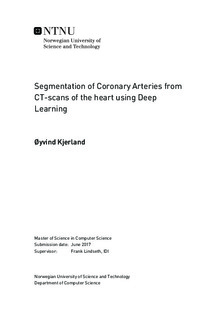| dc.description.abstract | Image segmentation is an important tool in several fields. One is medical image computing where the images are divided into regions based on tissue type and organ, which can further be used for visualization and diagnosis. Due to the large amount of data produced by modern imaging modalities such as CT and MRI, the process of manual or semi-automatic segmentation is time consuming, tedious and introduces bias by clinical experts. Recent advances in the field of deep learning has given rise to several fully automatic methods for robust segmentation on a large variety of segmentation tasks. In this thesis the use of a 3D convolutional neural network architecture is used on three different segmentation tasks is explored. These tasks are coronary artery segmentation, brain tumor segmentation and digital rock segmentation.
Coronary artery disease is the leading cause of death in Europe. Diagnosis of the disease is today done by invasive methods, but research on using computational fluid dynamics to model the blood flow based on non-invasive imaging show great promise. In this thesis a method for fully automatic segmentation of the coronary arteries based on deep learning is proposed, implemented and evaluated on a dataset provided by St. Olavs Hospital. The dataset contains manual segmentations performed by a clinical expert. The proposed method uses two neural networks trained on aorta segmentation and coronary segmentation respectively and is able to segment the complete coronary artery tree in some test images, but fails to segment all branches in the rest of the images.
For the brain tumor segmentation task a network is trained and evaluated on a dataset provided by the Norwegian National Advisory Unit for Ultrasound and Image Guided Therapy (USIGT). The results show that the deep learning method is able to produce good segmentations fully automatically. These segmentations do however inlcude some spurious responses.
Digital Rocks technology is based on using high resolution 3D microscopy imaging to create models describing reservoir rock. A network was trained and evaluated on a digital rock dataset provided by FEI. The results show that the network is able to produce good segmentations fully automatically. | |

